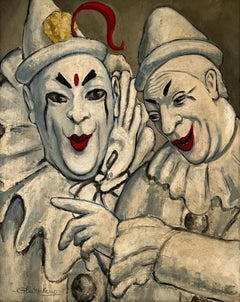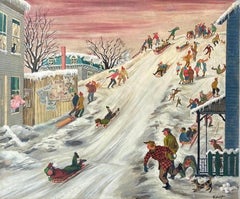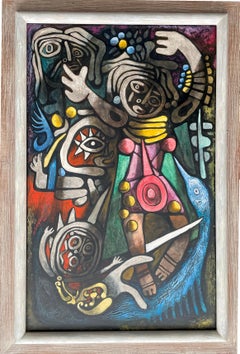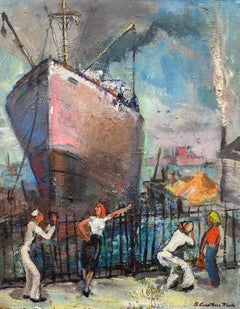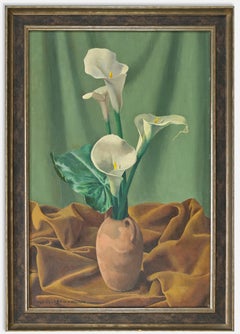Wood Figurative Paintings
to
7
29
2
23
2
20
11
1
8
11
4
7
Overall Height
to
Overall Width
to
13
2
2
1
1
1
22
12
10
7
6
5
4
3
2
2
2
1
1
1
1
1
1
1
1
1
29
49
356
700
4
2
5
14
31
47
55
30
34
30
8
5
4
2
1
1
304,774
543
446
226
202
Period: 1940s
Medium: Wood
"Clowns: Aren't We All?" Henry Glintenkamp, WPA Era Circus Figures, Modern
Located in New York, NY
Hendrik (Henry) J Glintenkamp
Clowns: Aren't We All?, 1942
Signed lower left; signed, titled and dated on the reverse
Oil on Masonite
20 x 16 inches
The painter and illustrator Henr...
Category
1940s American Realist Wood Figurative Paintings
Materials
Masonite, Oil
'Seated Nude with Flowers' Paris, Louvre, Académie Chaumière, SFAA, LACMA
Located in Santa Cruz, CA
Accompanied by certificate of authenticity for Victor Di Gesu (American, 1914-1988) and painted circa 1955. Additional painting, verso, with old inscription by the artist's wife, Jan...
Category
1940s Post-Impressionist Wood Figurative Paintings
Materials
Oil, Masonite
Colliers Magazine 1947 American Scene Social Realism Modern Families in the Snow
Located in New York, NY
Colliers Magazine 1947 American Scene Social Realism Modern Families in the Snow
Katherine Wiggins (American 20th Century)
"The Shrimp"
20 x 24 inches
Egg tempera on masonite. c. 1...
Category
1940s American Realist Wood Figurative Paintings
Materials
Egg Tempera, Masonite
Ceremonial Dancers oil and tempera painting by Julio De Diego
Located in Hudson, NY
Artwork measures 48" x 30" and framed 56 ¼" x 38 ¼" x 3"
Provenance:
John Heller Gallery, NYC, circa 1975 (label verso)
The artist's daughter
Corbino Galleries, Sarasota, FL (1990)...
Category
1940s Modern Wood Figurative Paintings
Materials
Masonite, Oil, Tempera
“Fleet Week”
Located in Southampton, NY
Original oil on masonite painting of Fleet Week with sailors flirting with young women on the dock by the American artist, Sarah Pace Carothers Rhode. ...
Category
1940s Ashcan School Wood Figurative Paintings
Materials
Masonite, Oil
Still Life with Calla Lily - Oil on canvas by Ugo Celada da Virgilio - 1940s
Located in Roma, IT
Still life with Calla Lily is an oil painting on masonite realized by Ugo Celada da Virgilio.
Hand-signed on the lower left.
Provenance: Galerie Sigfrid O...
Category
1940s Contemporary Wood Figurative Paintings
Materials
Oil, Masonite
The Magician oil and tempera painting by Julio de Diego
Located in Hudson, NY
Julio De Diego’s Atomic Series paintings made an extraordinary statement regarding the shock and fear that accompanied the dawn of the nuclear age. In the artist’s own words, “Scientists were working secretly to develop formidable powers taken from the mysterious depths of the earth - with the power to make the earth useless! Then, the EXPLOSION! . . . we entered the Atomic Age, and from there the neo-Atomic war begins. Explosions fell everywhere and man kept on fighting, discovering he could fight without flesh.”
To execute these works, De Diego developed a technique of using tempera underpainting before applying layer upon layer of pigmented oil glazes. The result is paintings with surfaces which were described as “bonelike” in quality. The forms seem to float freely, creating a three-dimensional visual effect. In the 1954 book The Modern Renaissance in American Art, author Ralph Pearson summarizes the series as “a fantastic interpretation of a weighty theme. Perhaps it is well to let fantasy and irony appear to lighten the devastating impact. By inverse action, they may in fact increase its weight.”
Exhibited
1964 Marion Koogler McNay Art Institute, San Antonio, Texas
This work retains its original frame which measures 54" x 42" x 2"
About this artist: Julio De Diego crafted a formidable persona within the artistic developments and political struggles of his time. The artist characterized his own work as “lyrical,” explaining, “through the years, the surrealists, the social-conscious painters and the others tried to adopt me, but I went my own way, good, bad or indifferent.” [1] His independence manifested early in life when de Diego left his parent’s home in Madrid, Spain, in adolescence following his father’s attempts to curtail his artistic aspirations. At the age of fifteen he held his first exhibition, set up within a gambling casino. He managed to acquire an apprenticeship in a studio producing scenery for Madrid’s operas, but moved from behind the curtains to the stage, trying his hand at acting and performing as an extra in the Ballet Russes’ Petrouchka with Nijinsky. He spent several years in the Spanish army, including a six-month stretch in the Rif War of 1920 in Northern Africa. His artistic career pushed ahead as he set off for Paris and became familiar with modernism’s forays into abstraction, surrealism, and cubism.
The artist arrived in the U.S. in 1924 and settled in Chicago two years later. He established himself with a commission for the decoration of two chapels in St. Gregory’s Church. He also worked in fashion illustration, designed magazine covers and developed a popular laundry bag for the Hotel Sherman. De Diego began exhibiting through the Art Institute of Chicago in 1929, and participated in the annual Chicago Artists Exhibitions, Annual American Exhibitions, and International Water Color Exhibitions. He held a solo exhibition at the Art Institute of Chicago in the summer of 1935. Though the artist’s career was advancing, his family life had deteriorated. In 1932 his first marriage dissolved, and the couple’s young daughter Kiriki was sent to live with friend Paul Hoffman.
De Diego continued to develop his artistic vocabulary with a growing interest in Mexican art. He traveled throughout the country acquainting himself with the works of muralists such as Carlos Merida, and also began a collection of small native artifacts...
Category
1940s American Modern Wood Figurative Paintings
Materials
Masonite, Oil, Tempera
St. Atomic oil and tempera painting by Julio de Diego
Located in Hudson, NY
Julio De Diego’s Atomic Series paintings made an extraordinary statement regarding the shock and fear that accompanied the dawn of the nuclear age. In the artist’s own words, “Scientists were working secretly to develop formidable powers taken from the mysterious depths of the earth - with the power to make the earth useless! Then, the EXPLOSION! . . . we entered the Atomic Age, and from there the neo-Atomic war begins. Explosions fell everywhere and man kept on fighting, discovering he could fight without flesh.”
To execute these works, De Diego developed a technique of using tempera underpainting before applying layer upon layer of pigmented oil glazes. The result is paintings with surfaces which were described as “bonelike” in quality. The forms seem to float freely, creating a three-dimensional visual effect. In the 1954 book The Modern Renaissance in American Art, author Ralph Pearson summarizes the series as “a fantastic interpretation of a weighty theme. Perhaps it is well to let fantasy and irony appear to lighten the devastating impact. By inverse action, they may in fact increase its weight.”
Exhibited
1950 University of Illinois at Urbana "Contemporary American Painting"
1964 Marion Koogler McNay Art Institute, San Antonio, Texas
This work retains its original frame which measures 54" x 36" x 2".
About this artist: Julio De Diego crafted a formidable persona within the artistic developments and political struggles of his time. The artist characterized his own work as “lyrical,” explaining, “through the years, the surrealists, the social-conscious painters and the others tried to adopt me, but I went my own way, good, bad or indifferent.” [1] His independence manifested early in life when de Diego left his parent’s home in Madrid, Spain, in adolescence following his father’s attempts to curtail his artistic aspirations. At the age of fifteen he held his first exhibition, set up within a gambling casino. He managed to acquire an apprenticeship in a studio producing scenery for Madrid’s operas, but moved from behind the curtains to the stage, trying his hand at acting and performing as an extra in the Ballet Russes’ Petrouchka with Nijinsky. He spent several years in the Spanish army, including a six-month stretch in the Rif War of 1920 in Northern Africa. His artistic career pushed ahead as he set off for Paris and became familiar with modernism’s forays into abstraction, surrealism, and cubism.
The artist arrived in the U.S. in 1924 and settled in Chicago two years later. He established himself with a commission for the decoration of two chapels in St. Gregory’s Church. He also worked in fashion illustration, designed magazine covers and developed a popular laundry bag for the Hotel Sherman. De Diego began exhibiting through the Art Institute of Chicago in 1929, and participated in the annual Chicago Artists Exhibitions, Annual American Exhibitions, and International Water Color Exhibitions. He held a solo exhibition at the Art Institute of Chicago in the summer of 1935. Though the artist’s career was advancing, his family life had deteriorated. In 1932 his first marriage dissolved, and the couple’s young daughter Kiriki was sent to live with friend Paul Hoffman.
De Diego continued to develop his artistic vocabulary with a growing interest in Mexican art. He traveled throughout the country acquainting himself with the works of muralists such as Carlos Merida, and also began a collection of small native artifacts...
Category
1940s American Modern Wood Figurative Paintings
Materials
Masonite, Oil, Tempera
Inevitable Day – Birth of the Atom oil and tempera painting by Julio De Diego
Located in Hudson, NY
Julio De Diego’s Atomic Series paintings made an extraordinary statement regarding the shock and fear that accompanied the dawn of the nuclear age. In the artist’s own words, “Scientists were working secretly to develop formidable powers taken from the mysterious depths of the earth - with the power to make the earth useless! Then, the EXPLOSION! . . . we entered the Atomic Age, and from there the neo-Atomic war begins. Explosions fell everywhere and man kept on fighting, discovering he could fight without flesh.”
To execute these works, De Diego developed a technique of using tempera underpainting before applying layer upon layer of pigmented oil glazes. The result is paintings with surfaces which were described as “bonelike” in quality. The forms seem to float freely, creating a three-dimensional visual effect. In the 1954 book The Modern Renaissance in American Art, author Ralph Pearson summarizes the series as “a fantastic interpretation of a weighty theme. Perhaps it is well to let fantasy and irony appear to lighten the devastating impact. By inverse action, they may in fact increase its weight.”
Bibliography
Art in America, April 1951, p.78
About this artists: Julio De Diego crafted a formidable persona within the artistic developments and political struggles of his time. The artist characterized his own work as “lyrical,” explaining, “through the years, the surrealists, the social-conscious painters and the others tried to adopt me, but I went my own way, good, bad or indifferent.” [1] His independence manifested early in life when de Diego left his parent’s home in Madrid, Spain, in adolescence following his father’s attempts to curtail his artistic aspirations. At the age of fifteen he held his first exhibition, set up within a gambling casino. He managed to acquire an apprenticeship in a studio producing scenery for Madrid’s operas, but moved from behind the curtains to the stage, trying his hand at acting and performing as an extra in the Ballet Russes’ Petrouchka with Nijinsky. He spent several years in the Spanish army, including a six-month stretch in the Rif War of 1920 in Northern Africa. His artistic career pushed ahead as he set off for Paris and became familiar with modernism’s forays into abstraction, surrealism, and cubism.
The artist arrived in the U.S. in 1924 and settled in Chicago two years later. He established himself with a commission for the decoration of two chapels in St. Gregory’s Church. He also worked in fashion illustration, designed magazine covers and developed a popular laundry bag for the Hotel Sherman. De Diego began exhibiting through the Art Institute of Chicago in 1929, and participated in the annual Chicago Artists Exhibitions, Annual American Exhibitions, and International Water Color Exhibitions. He held a solo exhibition at the Art Institute of Chicago in the summer of 1935. Though the artist’s career was advancing, his family life had deteriorated. In 1932 his first marriage dissolved, and the couple’s young daughter Kiriki was sent to live with friend Paul Hoffman.
De Diego continued to develop his artistic vocabulary with a growing interest in Mexican art. He traveled throughout the country acquainting himself with the works of muralists such as Carlos Merida, and also began a collection of small native artifacts...
Category
1940s American Modern Wood Figurative Paintings
Materials
Masonite, Oil, Tempera
"Swapping Horses" Fred E. Robertson, Grandma Moses, Self-Taught Landscape
Located in New York, NY
Fred E. Robertson (1878 - 1953)
Swapping Horses, 1947
Signed and dated lower right
Oil on masonite
12 5/8 x 24 inches
Fred Robertson, like his more famous older sister, Anna Mary Ro...
Category
1940s Folk Art Wood Figurative Paintings
Materials
Masonite, Oil
"Neighborhood Shivaree, " Fred E. Robertson, Grandma Moses, Self-Taught Landscape
Located in New York, NY
Fred E. Robertson (1878 - 1953)
Neighborhood Shivaree, 1945
Signed and dated lower left
Oil on masonite
16 x 20 inches
Exhibited:
Buffalo, The Buffalo Fine Arts Academy, Albright A...
Category
1940s Folk Art Wood Figurative Paintings
Materials
Masonite, Oil
Victor, Colorado, 1940s Modernist Mountain Landscape with Town, Mining Town
By Martyl Suzanne Schweig Langsdorf
Located in Denver, CO
'Victor, Colorado', 1942 oil painting on masonite by Martyl Suzanne Schweig (1918-2013). This classic Colorado landscape was painted overlooking a ghost town with the Rocky Mountains visible across the background, completed in rich tones of green, gold, and brown. This painting was completed on a trip with fellow artist, Adolph Dehn...
Category
1940s American Modern Wood Figurative Paintings
Materials
Masonite, Oil
“Woman with Orange Necklace”
Located in Southampton, NY
Original oil on hardboard (a type of masonite) painting by the Russian American artist, Nahum Tschacbasov. Signed, dated 1946 along with a dedication to his wife on their 17th wedding anniversary. Condition is very good. The back of the painting has a sketch as well by Nahum Tschacbasov. Framed in a semi-antique ornate gold frame...
Category
1940s Modern Wood Figurative Paintings
Materials
Oil, Masonite
NYC Subway Mid 20th Century American Modernism WPA Realism industrial Colorful
Located in New York, NY
NYC Subway Mid 20th Century American Modernism WPA Realism industrial Colorful
"New York Subway," 36 x 48 inches. Oil on Masonite (backed with a wood frame), Signed and dated ’47 upper left. The colors of the painting are extraordinarily vibrant. The white gold frame, signed Richard Tobey...
Category
1940s American Modern Wood Figurative Paintings
Materials
Masonite, Oil
Woman with a Goldfish
Located in Lawrence, NY
Oil on masonite.
Russian-Jewish-American artist Nahum Tschacbasov (1899-1984) is known for his intriquing cubo-surrealistic-symbolist works which feature a strong psychological elem...
Category
1940s Surrealist Wood Figurative Paintings
Materials
Oil, Masonite
Mid Century Dutch Figurative Landscape, Monochrome Watercolor Sketch
Located in Soquel, CA
Beautiful mid century Dutch figurative landscape watercolor of a group of figures at a harbor, two young girls and three men conversing beside a fishing dock with sailboats in the ba...
Category
1940s Impressionist Wood Figurative Paintings
Materials
Paper, Masonite, Watercolor
Environs of Rome
Located in Miami, FL
Klett was an in-demand illustrator in the post-war period of the late 1940's and 1950's. and . His work appeared in many of the newsstand magazines at the time.
This work is a pers...
Category
1940s Surrealist Wood Figurative Paintings
Materials
Oil, Masonite
1940s Southwestern Figurative Landscape -- Pueblo Village New Mexico
Located in Soquel, CA
Gorgeous 1940s New Mexico village scene with small figures going about daily life among adobe buildings that are iconic of the Southwest, by William “Will” Frates (American, 1896-1969). Signed "Will FRATES" in the lower right corner. Titled "New Mexico Village" and Will Frates" on verso in pencil. Unframed. Image size: 24"H x 29.5"W.
William Frates...
Category
1940s American Impressionist Wood Figurative Paintings
Materials
Oil, Fiberboard, Masonite
Laurel & Hardy
Located in Fort Washington, PA
Medium: Oil on Wood Panel
Signature: Unsigned
This Stan Laurel and Oliver Hardy illustration was used as a traveling show sign.
Category
1940s Wood Figurative Paintings
Materials
Oil, Wood, Panel, Wood Panel
Gondola In Venice, 1947
By Tom Lovell
Located in Fort Washington, PA
Medium: Oil on Masonite
Signature: Signed Upper Left
Original Use: Interior Illustration for The American Magazine
Excellent Condition
This luminous, expressive oil on masonite wa...
Category
1940s Wood Figurative Paintings
Materials
Oil, Masonite
Paris, Hotel des Saint Pères - Oil on Masonite by F. De Pisis - 1948
Located in Roma, IT
Oil painting on Masotine realized by the Artist in 1948.
Image dimensions: 65x38 cm.
Artist paints the Hotel where he used to live in Paris during those years.
Note, title, date and ...
Category
1940s Wood Figurative Paintings
Materials
Masonite, Oil
Untitled
Located in Fort Washington, PA
Signature: Signed Lower Right
Medium: Oil on Masonite
Category
1940s Wood Figurative Paintings
Materials
Oil, Masonite
"Theresa Thompson"
Located in Lambertville, NJ
Jim’s of Lambertville is proud to offer this artwork by:
Gershon Benjamin (1899-1985)
An American Modernist of portraits, landscapes, still lives, and the urban scene, Gershon Benj...
Category
1940s Modern Wood Figurative Paintings
Materials
Oil, Masonite
Boy with Molotov Cocktail, Russia Invades Germany
Located in Miami, FL
This work sells itself. Just look at it and an elaborate explanation is not required. There is virtually no one alive who can paint a picture like Crockwell. Hand-signed by artist, sticker label, Signed lower left
Provenance: National Museum of American Illustration , Newport, Rhode Island
Crockwell gives us a complex and inventive composition by showing two wonderful portaits in the foreground and beyond a broken wall...
Category
1940s American Realist Wood Figurative Paintings
Materials
Masonite, Oil
"Rushelle in the Garden"
Located in Lambertville, NJ
Jim’s of Lambertville is proud to offer this artwork by:
Gershon Benjamin (1899 - 1985)
An American Modernist of portraits, landscapes, still lives, and the urban scene, Gershon ...
Category
1940s Modern Wood Figurative Paintings
Materials
Oil, Masonite
Spring
Located in New York, NY
Oil on masonite
Signed and dated, l.r.
This painting is offered by ClampArt, located in New York City.
About the artist:
Konrad Cramer grew up in Wurtzburg, Germany, and attended the Karlsruhe Academy. He was a member of Der Blaue Reiter...
Category
1940s Modern Wood Figurative Paintings
Materials
Masonite, Oil
"Untitled"
Located in Southampton, NY
Oil on masonite painting by the well known Russian/American artist, Nahum Tschacbasov. Signed lower right and dated 1946. In good condition. The painting is framed in a contemporary...
Category
1940s Modern Wood Figurative Paintings
Materials
Oil, Masonite
Icing the Cake, Cover of The Saturday Evening Post
Located in Fort Washington, PA
Medium: Gouache and Tempera on Masonite
Sight Size 14.50" x 11.25", Framed 20.50" x 17.25"
Signature: Signed Lower Right
Cover of The Saturday Evening Post, June 16, 1945
Category
1940s Wood Figurative Paintings
Materials
Masonite, Tempera, Gouache
"Mystic Woman"
Located in Southampton, NY
This is a oil on masonite painting by Nahum Tschacbasov done in 1946. Signed lower left and housed in a hand carved wood frame circa 1920. Overall size with frame is 40 x 33 inches.
Category
1940s Abstract Expressionist Wood Figurative Paintings
Materials
Masonite, Oil
Fallen Comrades/Interlude
Located in Los Angeles, CA
This work is part of our exhibition - America Coast to Coast: Artists of the 1940s
Fallen Comrades/Interlude, 1949, oil on masonite, signed lower left, 35 x 56 inches; Gallery Z la...
Category
1940s American Modern Wood Figurative Paintings
Materials
Masonite, Oil
“Woman and Birds”
Located in Southampton, NY
Mid-century oil on masonite modern painting by the well known Russian/American artist, Nahum Tschacbasov. Signed top left and dated 1949. Titled verso. Condition is good. Provenanc...
Category
1940s American Modern Wood Figurative Paintings
Materials
Masonite, Oil
Wood figurative paintings for sale on 1stDibs.
Find a wide variety of authentic Wood figurative paintings available on 1stDibs. While artists have worked in this medium across a range of time periods, art made with this material during the 21st Century is especially popular. If you’re looking to add figurative paintings created with this material to introduce a provocative pop of color and texture to an otherwise neutral space in your home, the works available on 1stDibs include elements of pink, blue, red, orange and other colors. There are many well-known artists whose body of work includes ceramic sculptures. Popular artists on 1stDibs associated with pieces like this include Enzio Wenk, Mark Beard, Purvis Young, and Bruce Adams. Frequently made by artists working in the Contemporary, Abstract, all of these pieces for sale are unique and many will draw the attention of guests in your home. Not every interior allows for large Wood figurative paintings, so small editions measuring 0.1 inches across are also available
